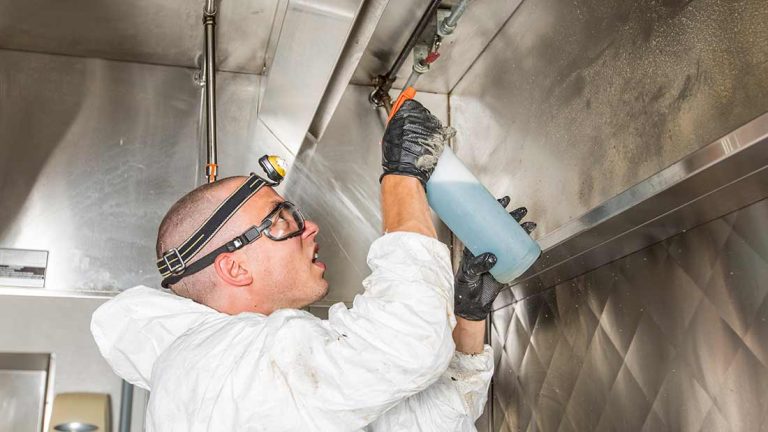Key Takeaways
- Pre-Cleaning Phase – Before cleaning begins, it’s crucial to understand the specific kitchen environment that is being worked on. This is best handled via a comprehensive kitchen audit of fans, access panels etc..
- Planning Phase – With the audit done, it’s time to pinpoint susceptible hazards and specific areas that are likely to attract grease buildup and include them in the Cleaning Plan.
- Cleaning Phase – The cleaning process includes specialized techniques and equipment to remove accumulated grease and debris.
- Post-Cleaning Phase & Compliance – After cleaning, a thorough inspection and reporting process ensures the system meets safety and hygiene standards, providing peace of mind and documentation for compliance.
When it comes to maintaining a commercial kitchen, the cleaning of canopies and exhaust systems is not just a matter of cleanliness; it’s a matter of safety, compliance, and efficiency.
At the core of this process is a meticulous approach that begins long before any cleaning agents are applied and continues well after the last bit of grease is removed. In this blog, we delve into the detailed process of how a professional team tackles this task – from the crucial pre-cleaning preparations to the post-cleaning protocols that ensure ongoing cleanliness and compliance.
You’ll discover the targeted strategies for cleaning the most crucial areas, understand the importance of selecting the right cleaning frequency, and learn about the rigorous cleaning processes that protect against hazards like kitchen fires.
Each step of the way, our focus remains on maintaining the highest standards, ensuring that your commercial kitchen operates safely, efficiently, and in line with all regulatory requirements.
1) Pre-Cleaning Phase
A comprehensive pre-cleaning assessment is critical in setting the stage for a thorough and efficient cleaning process. This involves a detailed audit, including the evaluation of the number and types of fans, their specific locations, and the positioning of duct access panels. Understanding these elements is key to applying the most effective cleaning strategies tailored to each kitchen’s unique setup.
Equally important is the prevention of food contamination during the cleaning process. To ensure this, all food products are carefully stored in safe locations, and food preparation cookware and equipment are relocated. This not only safeguards kitchen items but also enables an unobstructed and efficient cleaning operation. These precautionary steps are essential for maintaining the highest standards of cleanliness and safety, and upholding the integrity of the kitchen environment.
2) Planning Phase
A strategic approach to cleaning commercial kitchen canopies and exhaust systems involves pinpointing areas that are most susceptible to grease buildup and potential hazards. Key areas of focus include:
- Canopy Interior – This area, being directly above the cooking equipment, accumulates significant grease and requires meticulous attention.
- Grease Filters – These are vital for trapping grease and must be regularly cleaned to maintain their efficiency.
- Ductwork – The ducts can harbour grease deposits that are not only a fire hazard but also hinder airflow efficiency.
- Exhaust Fans – These are crucial for ventilating the kitchen and need regular cleaning to function optimally.
By focusing on these key areas, the risk of fire hazards is significantly reduced, and the overall hygiene and efficiency of the kitchen are enhanced.
3) Cleaning Phase
The actual cleaning of commercial kitchen canopies and exhaust systems is a meticulous process that demands both precision and expertise. This involves several key steps:
- Degreasing – Using environmentally friendly, yet powerful, degreasing agents, the accumulated grease and grime are broken down. This is essential for ensuring that every inch of the canopy and exhaust system is free from combustible grease.
- Scrubbing and Steaming – Manual scrubbing, complemented by steam cleaning, reaches deep into every crevice, ensuring a comprehensive clean. This step is crucial for removing stubborn grease and preventing potential fire hazards.
- Ductwork Cleaning – Specialized tools and methods are employed to clean the ductwork thoroughly. This includes the use of rotary brushes and high-pressure cleaning techniques to remove grease from hard-to-reach areas.
- Fan and Motor Cleaning – Exhaust fans and motor surfaces are cleaned where possible to remove grease and ensure they operate at peak efficiency.
Throughout the cleaning process, care is taken to adhere to safety protocols, ensuring that the cleaning does not damage any part of the kitchen’s ventilation system. The goal is to restore the system to its optimum condition, reducing the risk of fire and improving air quality within the kitchen.
4) Post Cleaning Phase
The post-cleaning phase is as critical as the cleaning itself. It’s not just about leaving the kitchen canopy and exhaust systems spotlessly clean, it’s also about ensuring they meet and exceed safety and hygiene standards.
This final phase includes:
- Thorough Inspection – After cleaning, a detailed inspection is conducted to ensure every component is clean and functioning correctly. This includes checking for any missed spots or potential damage incurred during the cleaning process.
- Frequency – Determining the best-practice frequency for both compliance with safety standards and maintaining operational efficiency.
- Documentation and Reporting – A comprehensive report is prepared, documenting the cleaning process, the areas cleaned, and any observations or recommendations. This report serves as a record for compliance purposes and can be invaluable for future maintenance planning.
- Certification: – Certification is provided upon completion of the cleaning, indicating that the kitchen canopy and exhaust systems have been professionally cleaned and inspected. This certification is crucial for meeting health and safety regulations and can be necessary for insurance purposes.
- Client Walk-Through: – When possible, engaging with the client for a final walk-through ensures transparency and provides an opportunity to address any concerns or questions they may have about the cleaning process.
This post-cleaning phase not only ensures the long-term cleanliness and efficiency of the kitchen’s exhaust system but also reinforces the commitment to quality and safety, building trust and confidence with the client.
In conclusion, the cleaning of commercial kitchen canopies and exhaust systems is an intricate process that requires meticulous attention to detail, from the pre-cleaning preparations to the final post-cleaning inspections. By understanding what and where to focus during cleaning, implementing a thorough cleaning process, adhering to a regular cleaning schedule, and conducting a detailed post-cleaning review, kitchens can maintain the highest standards of cleanliness, safety, and compliance.
Remember, regular and professional cleaning of these systems is not just about maintaining appearances; it’s a critical practice for reducing fire risks, ensuring efficient kitchen operations, and complying with health and safety standards. By following these guidelines, kitchen operators can protect their establishments, their staff, and their patrons, ensuring a safe and efficient cooking environment.




